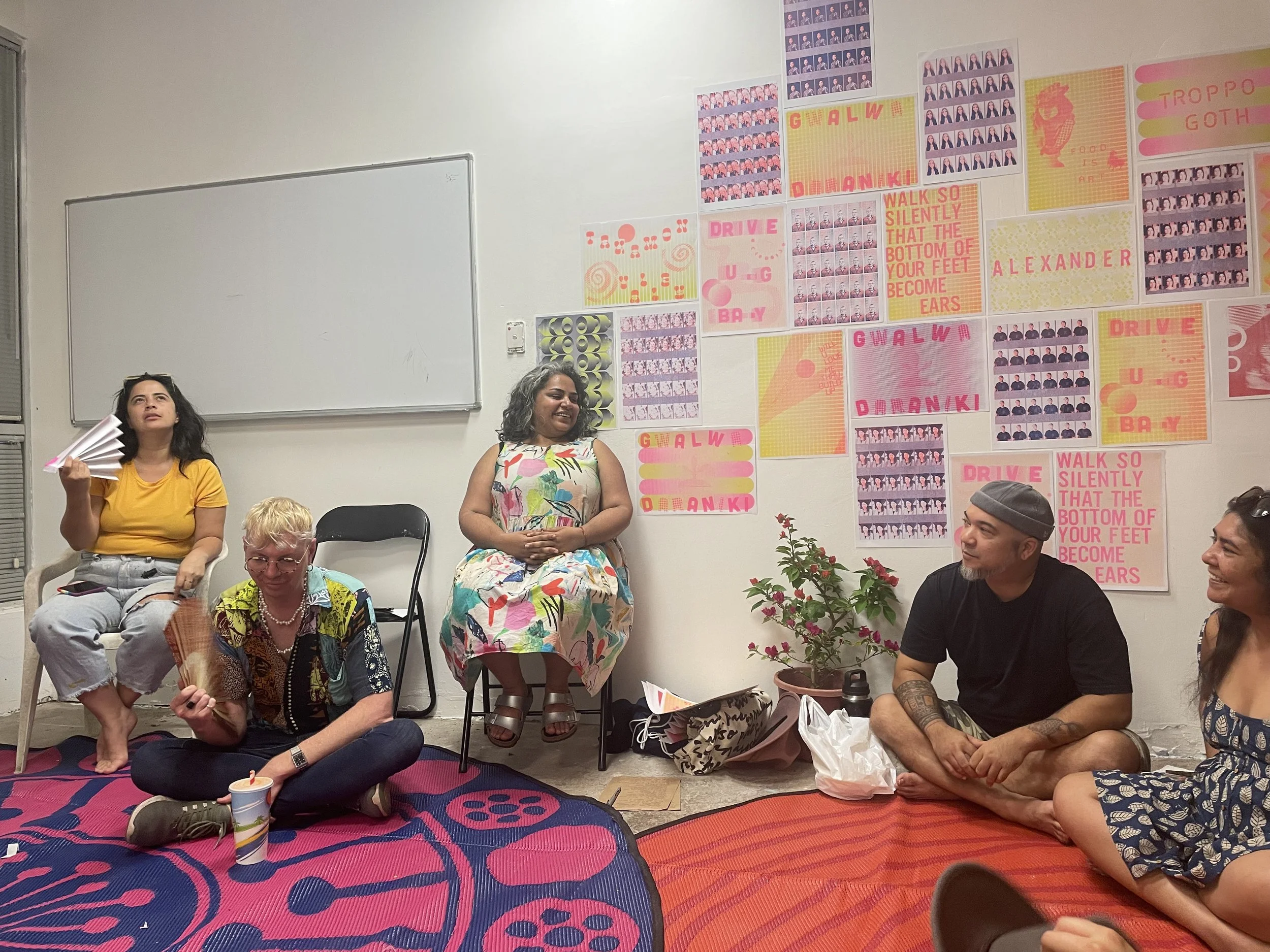Working at togetherness: Gurambai - Rapid Creek
An Invitation: Fragments, Not Conclusion
This is not a definitive account of Gurambai / Rapid Creek, but a collection of fragments — images, sounds, messages, reflections — that trace relational ripples, tensions, and entanglements. Each artefact might seem small or partial on its own, but together they form a kind of social collage: an ongoing attempt to be in relation.
These pieces emerge from my personal and evolving relationship with Gurambai — a creek whose presence is sometimes quiet, sometimes insistent. The work is also shaped by the everyday life of the surrounding suburbs: the Rapid Creek market, food shops, housing, foot traffic, infrastructure. These fragments sit in the friction and flow between creek and carpark, memory and routine, the ceremonial and the mundane.
As you scroll, I invite you to move slowly, follow what draws you in, and notice not just the artefacts, but what lingers between them.
Ongoing Questions
In this process, I’ve been shaped by the generosity and knowledge of Larrakia people, community conversations, and the seasonal and social energies that gather around the creek. This work holds care, but also uncertainty. I’m still learning how to listen. Still learning what the creek remembers — and what it might be asking of us.
A quiet question keeps surfacing: how are we in relation with the creek? Not just as backdrop, but as presence? As kin? I don’t have an answer. This exhibition doesn’t offer one. Instead, it leans gently into the tension. Inspired by readings like Human Nature (UNSW Press), I’m interested in what it means to sit inside the not-knowing — to be in ongoing, unfinished, and relational work.
Curatorial Note: Artefacts in Conversation
Each artefact is a ripple — shaped by radical hospitality, collaboration, and deep listening. This is not a fixed archive but a space of relation — where things sit beside each other in unexpected ways.
This exhibition moves like a rhizome: spreading sideways, looping back, making connections not through hierarchy or order, but through proximity and resonance. Within this assemblage, you’ll find photographs from the artists’ lab; moments from Radical Hospitality: MarketMarket; screenshots of messages with Uncle T — often sent spontaneously, with creek photos; and public-facing materials like posters and programs. These sit alongside seasonal images of Gurambai — in flood, in stillness, in retreat — offering a rhythm that pulses quietly throughout the work.
Also included are voice memos, debriefs, and scribbled notes — artefacts that surface the care that surrounded the work. These fragments mark where relational ethics were tested, where tension was felt, where insight emerged.
Among these artefacts are also a number of maps — some official, some informal, some drawn from memory. These maps do more than locate; they reveal. They gesture toward the social and political realities shaping Gurambai and its surrounds: zoning boundaries, land tenure, alcohol restrictions, suburb borders, and infrastructure overlays. They show us how power moves through space — and how that space is made visible or invisible in different ways. Maps sit alongside the more ephemeral materials to remind us that Country is not only walked and remembered — it is also administered, contested, and claimed through wild policy. Attending to how Gurambai is mapped is part of the ongoing, unfinished work of being in relation.
Toward the end of the exhibition, audio recordings of Gurambai — water, insects, birds, wind — offer a space of sensory attunement. These are not background sounds. They are companions. Reminders that Country is always speaking — if we choose to listen.
A Note on Process
Like the other exhibitions, this is just a snapshot — a glimpse of what has been collected, and what hasn’t. The real practices live elsewhere: in swimming, walking, sitting, eating with these spaces. In the quiet, daily ways of being with Gurambai. These encounters resist archiving. They happen off-record, off-camera, and often without words. Archived in the embodied relations, a soft response to Uncle T’s provocation at a Sweat Season dinner.
This body of work feels the most open — and perhaps the most exposed — because it’s still forming. It doesn’t know exactly where it’s going. But it knows it needs to stay open. It insists on ongoingness. And in doing so, it reminds me that uncertainty is not a weakness, but a practice.
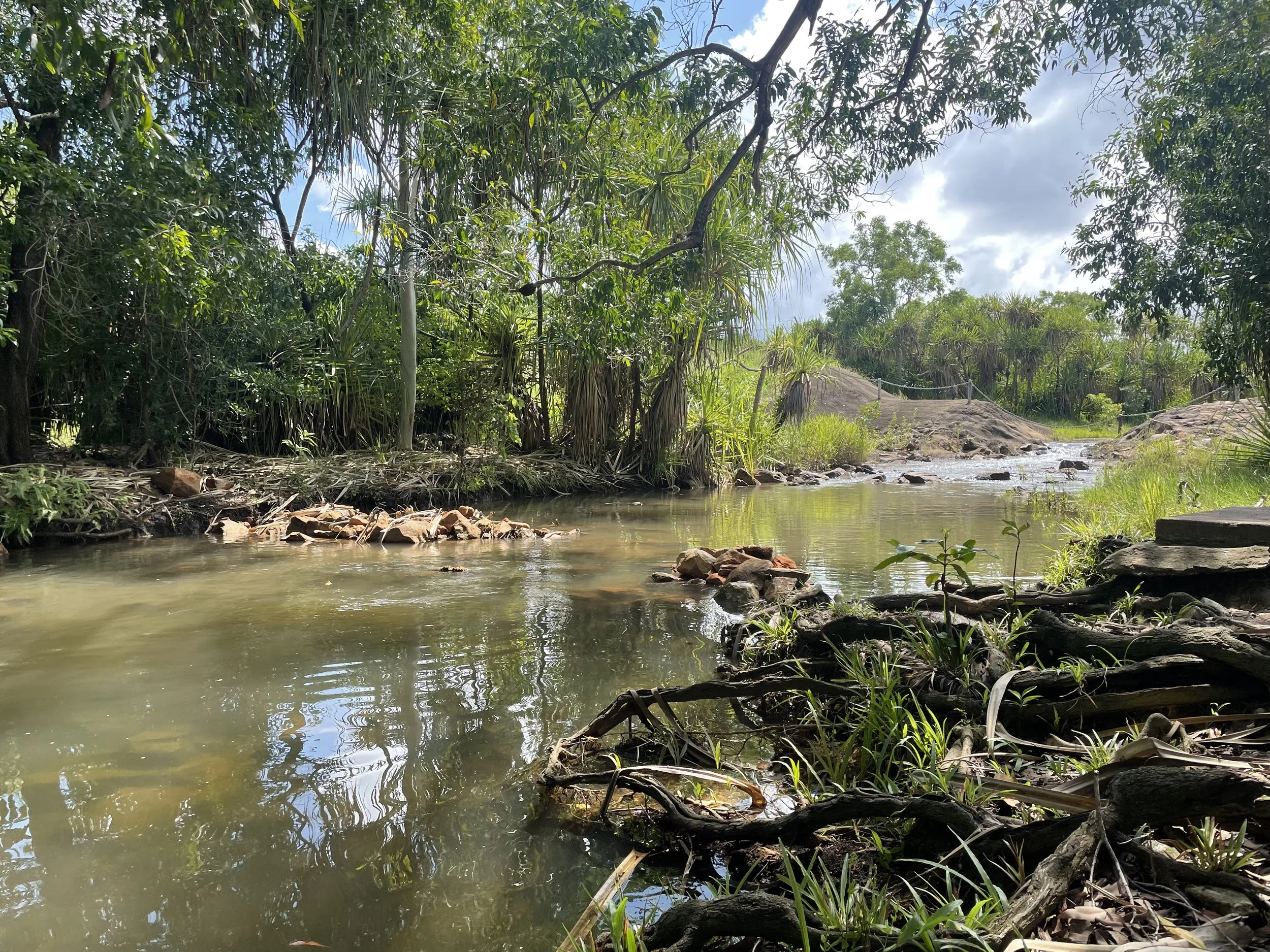
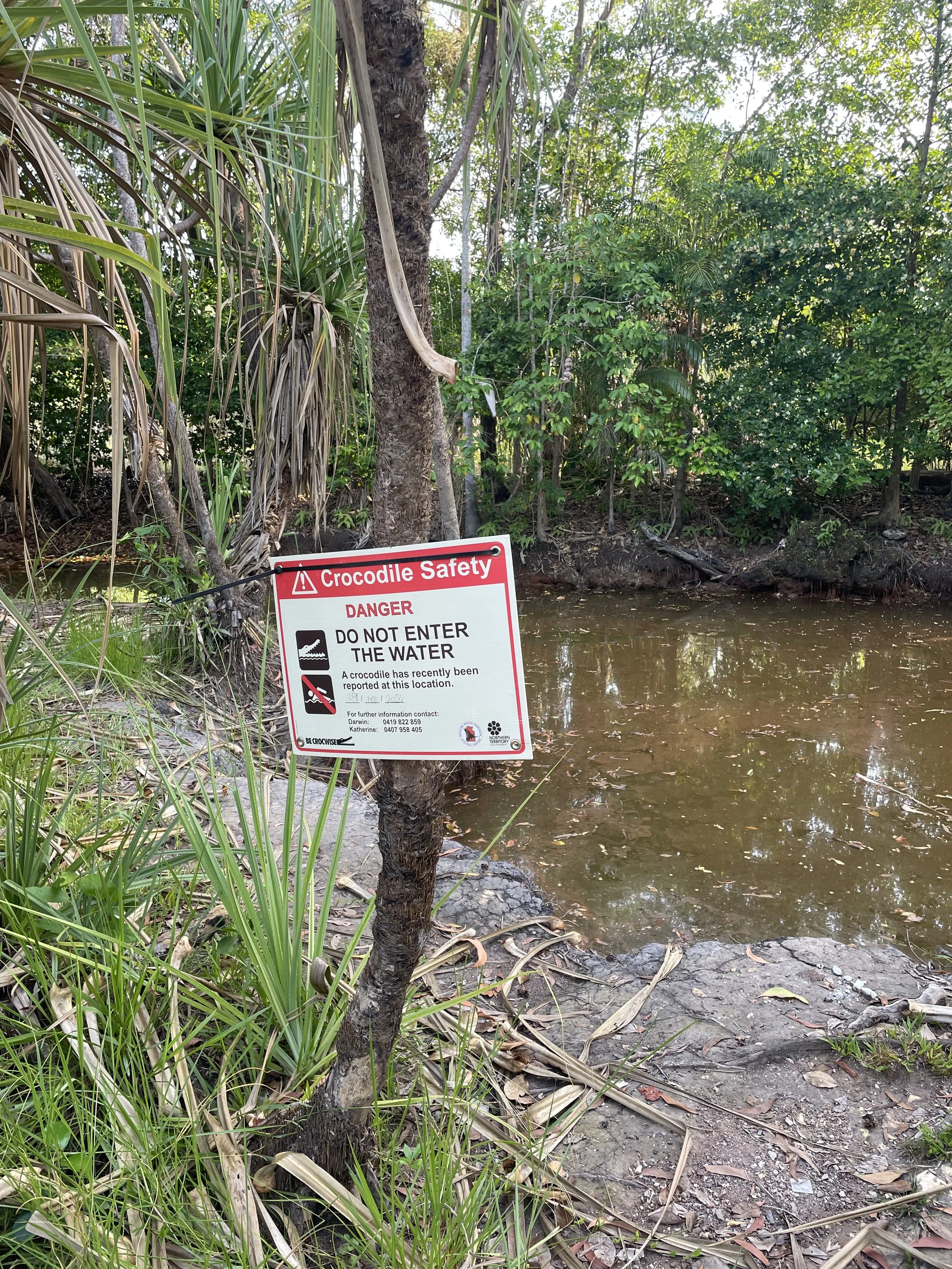

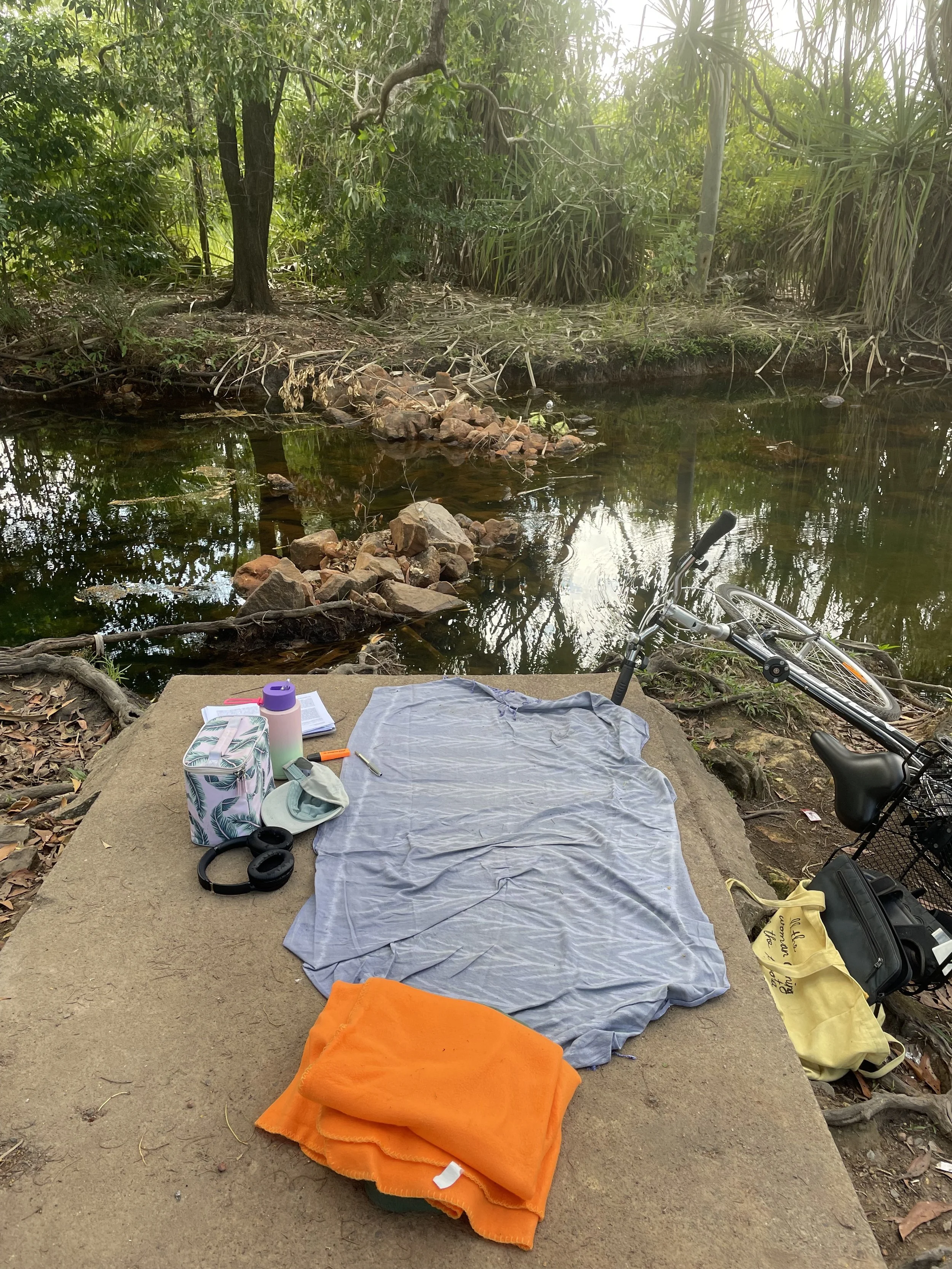





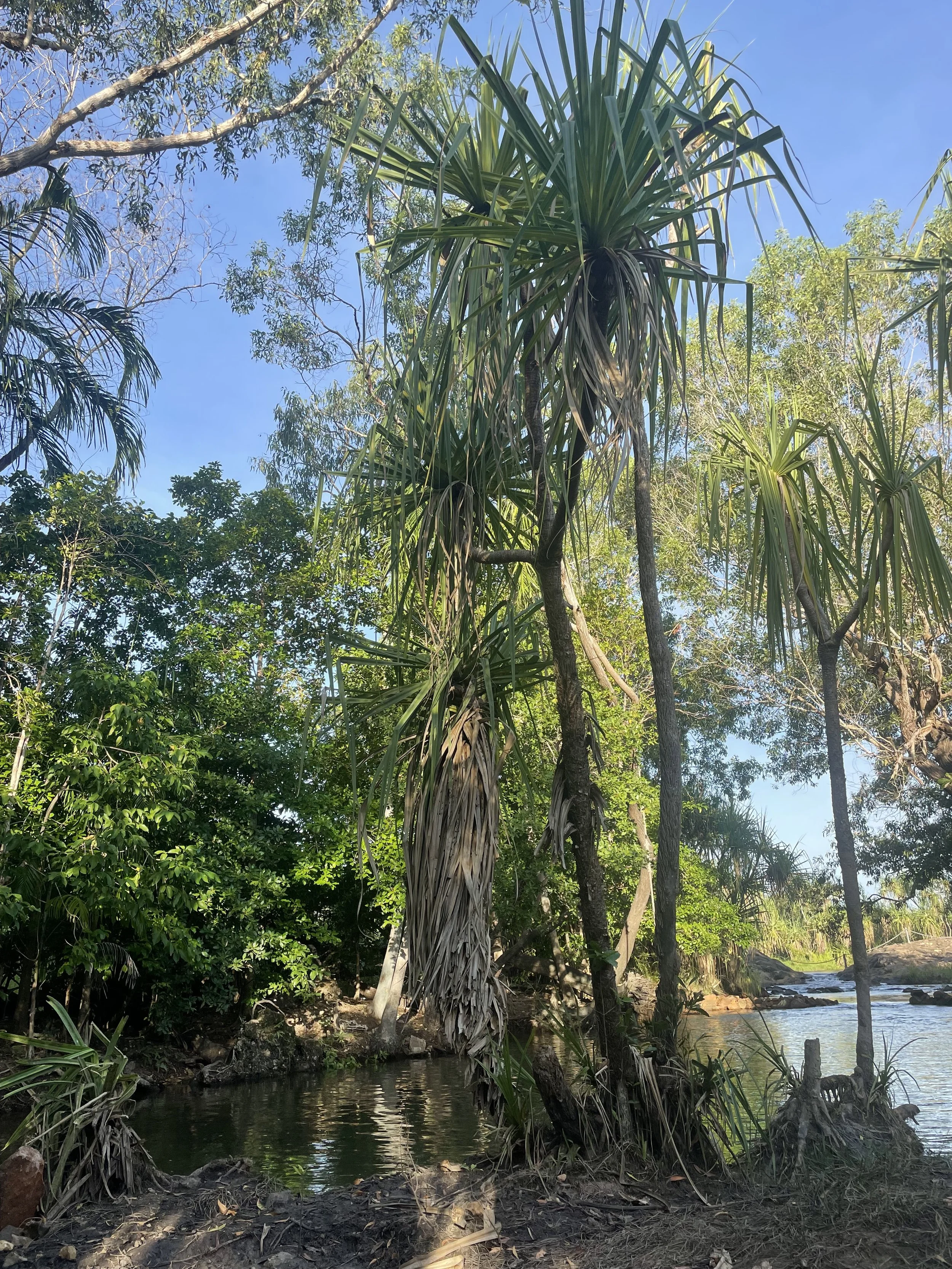
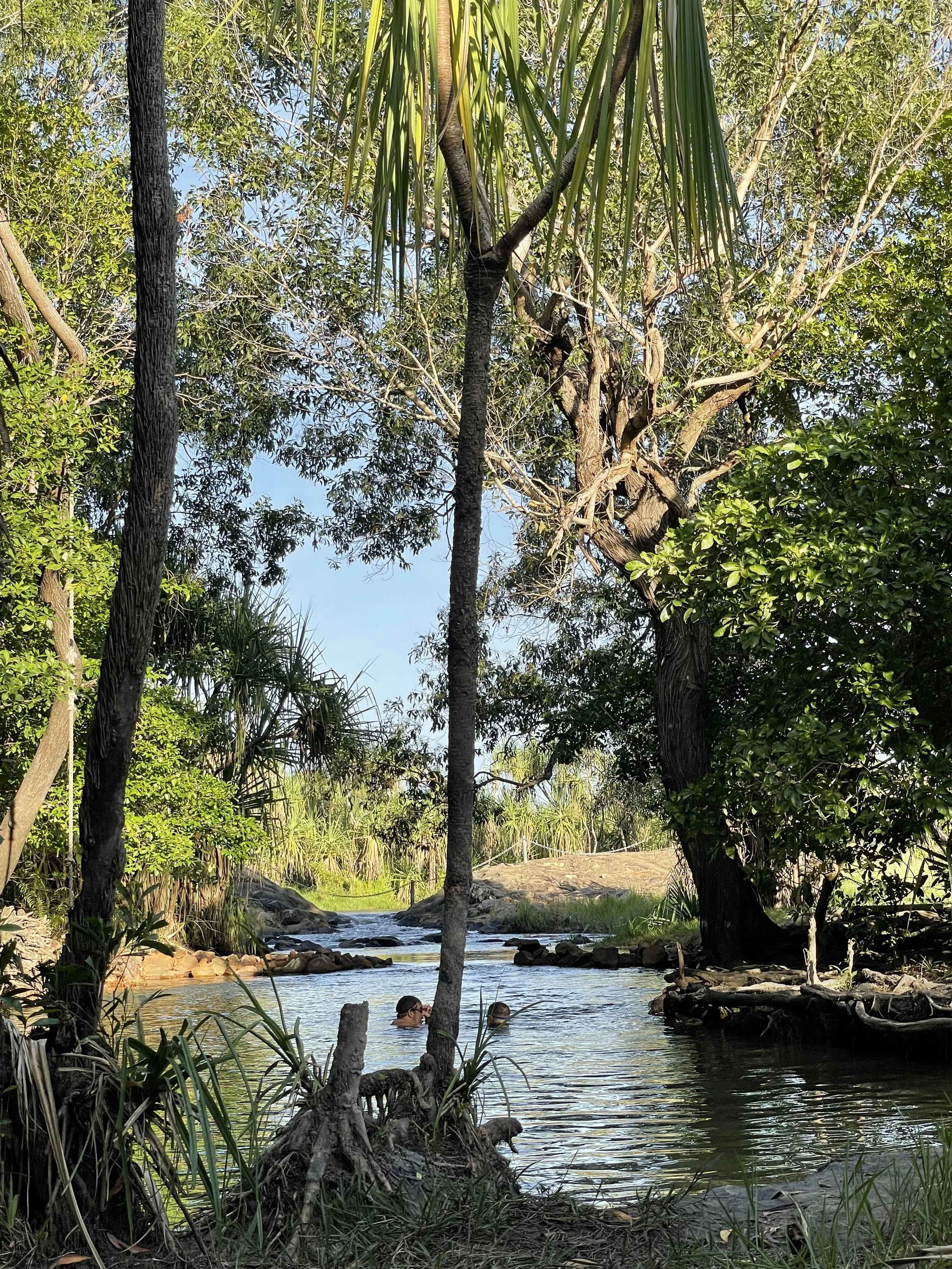

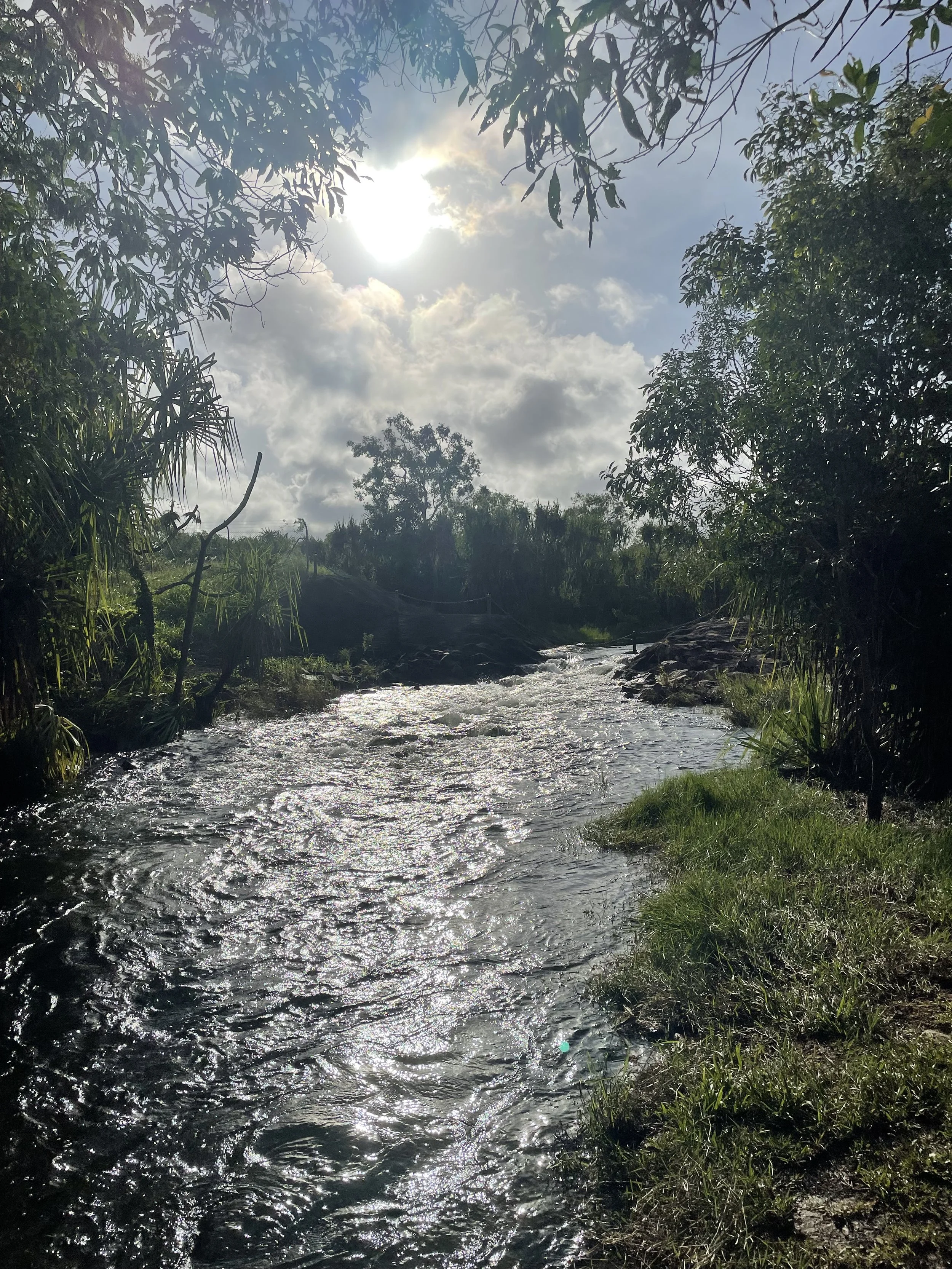



















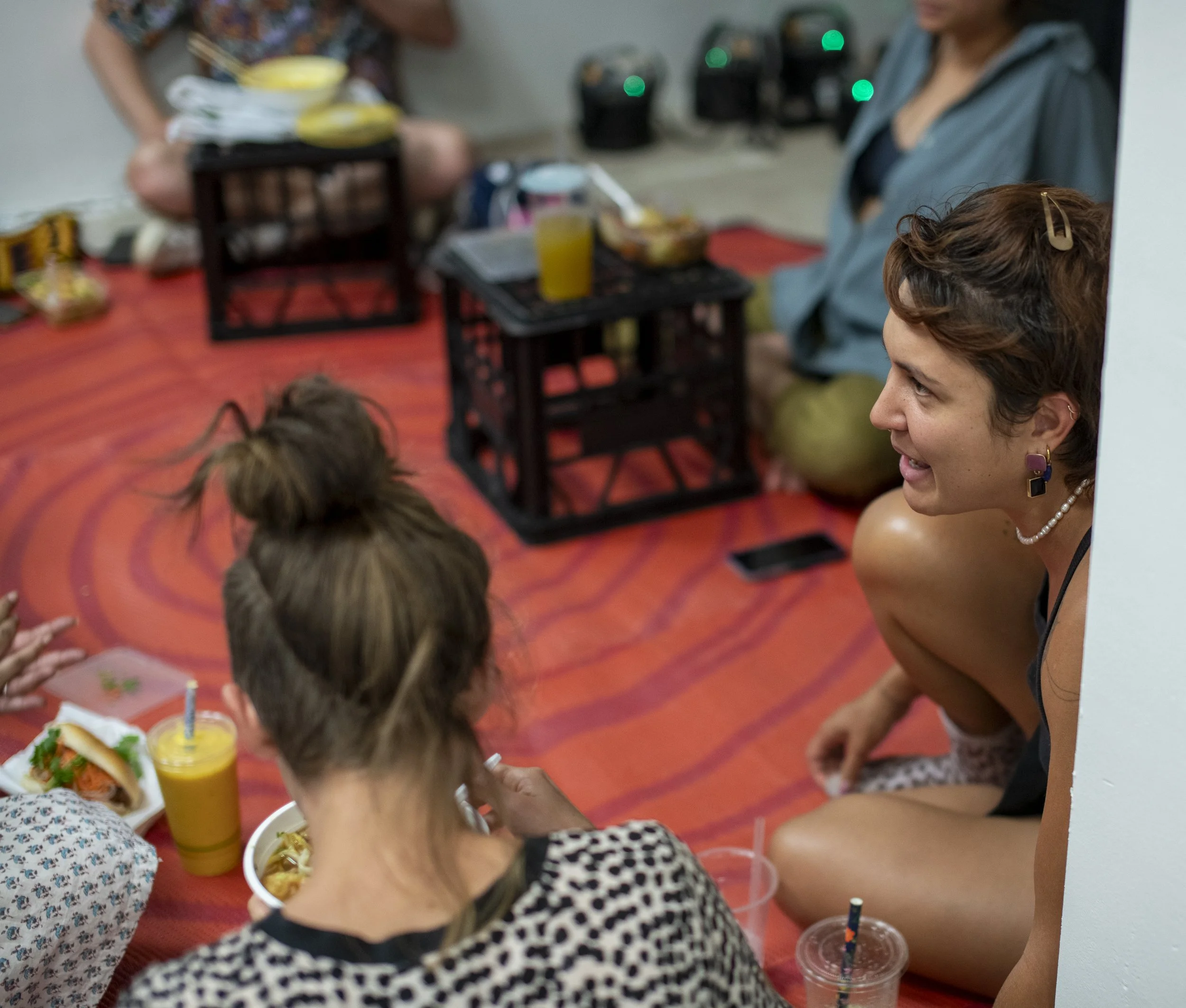




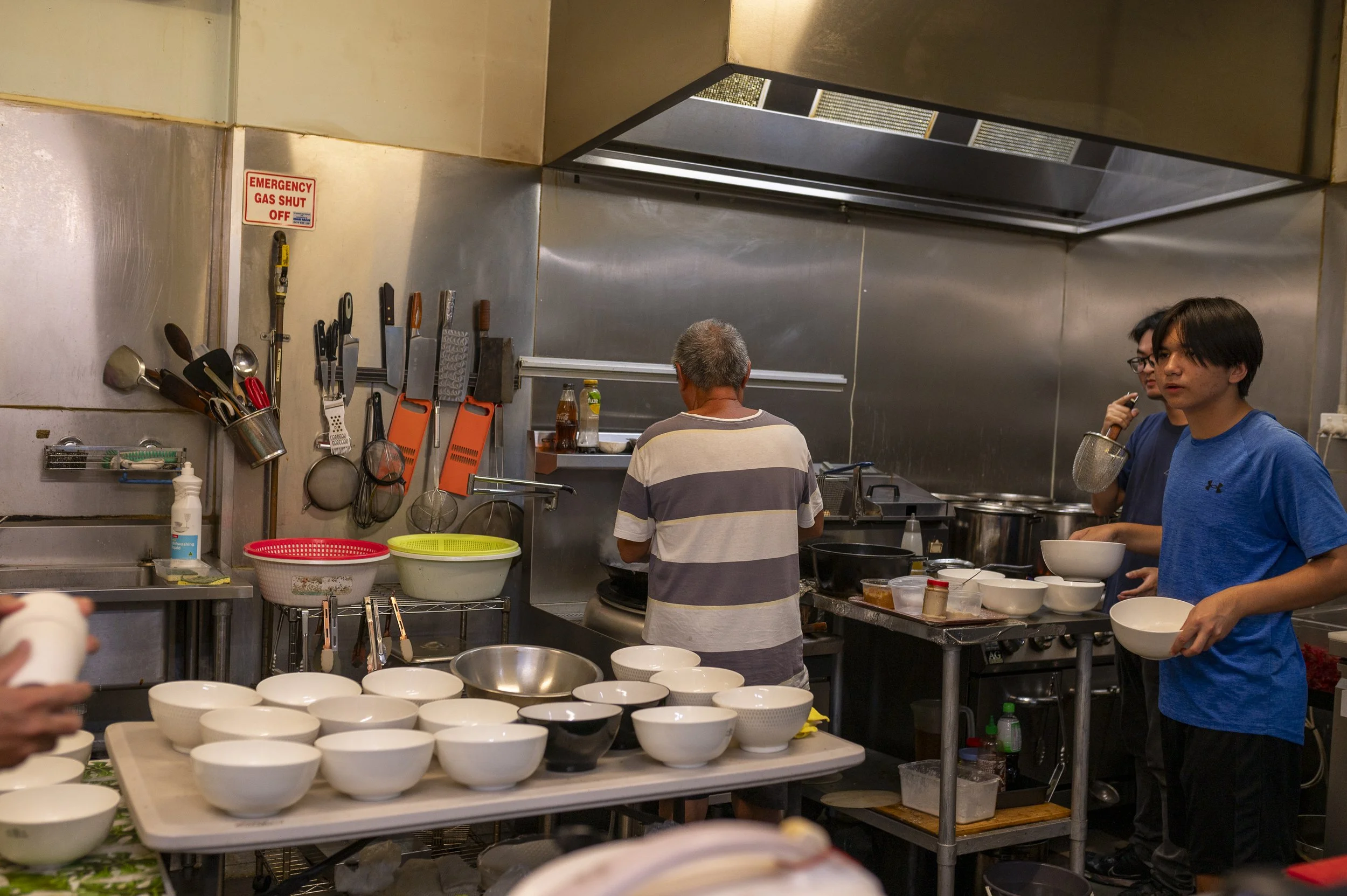
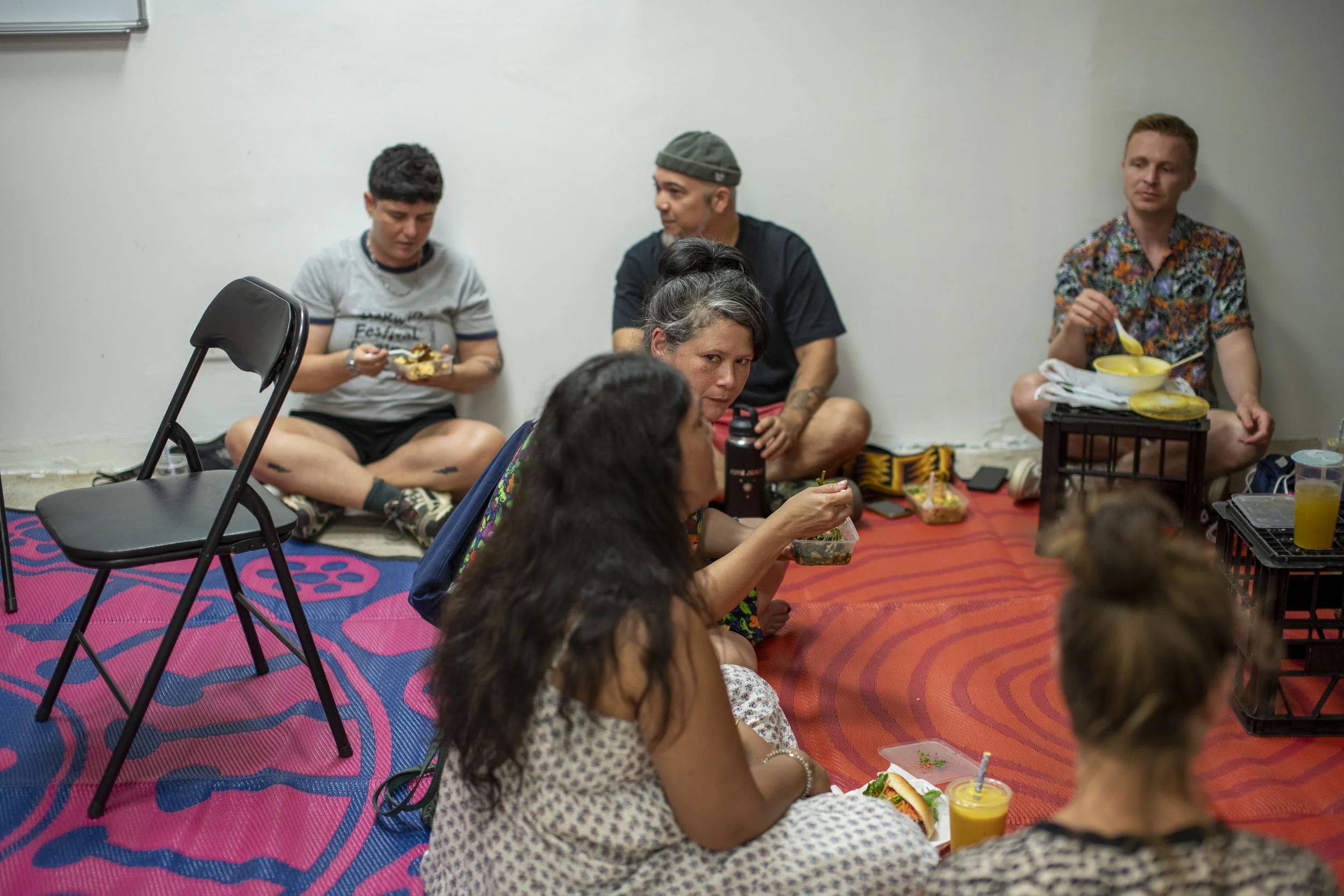




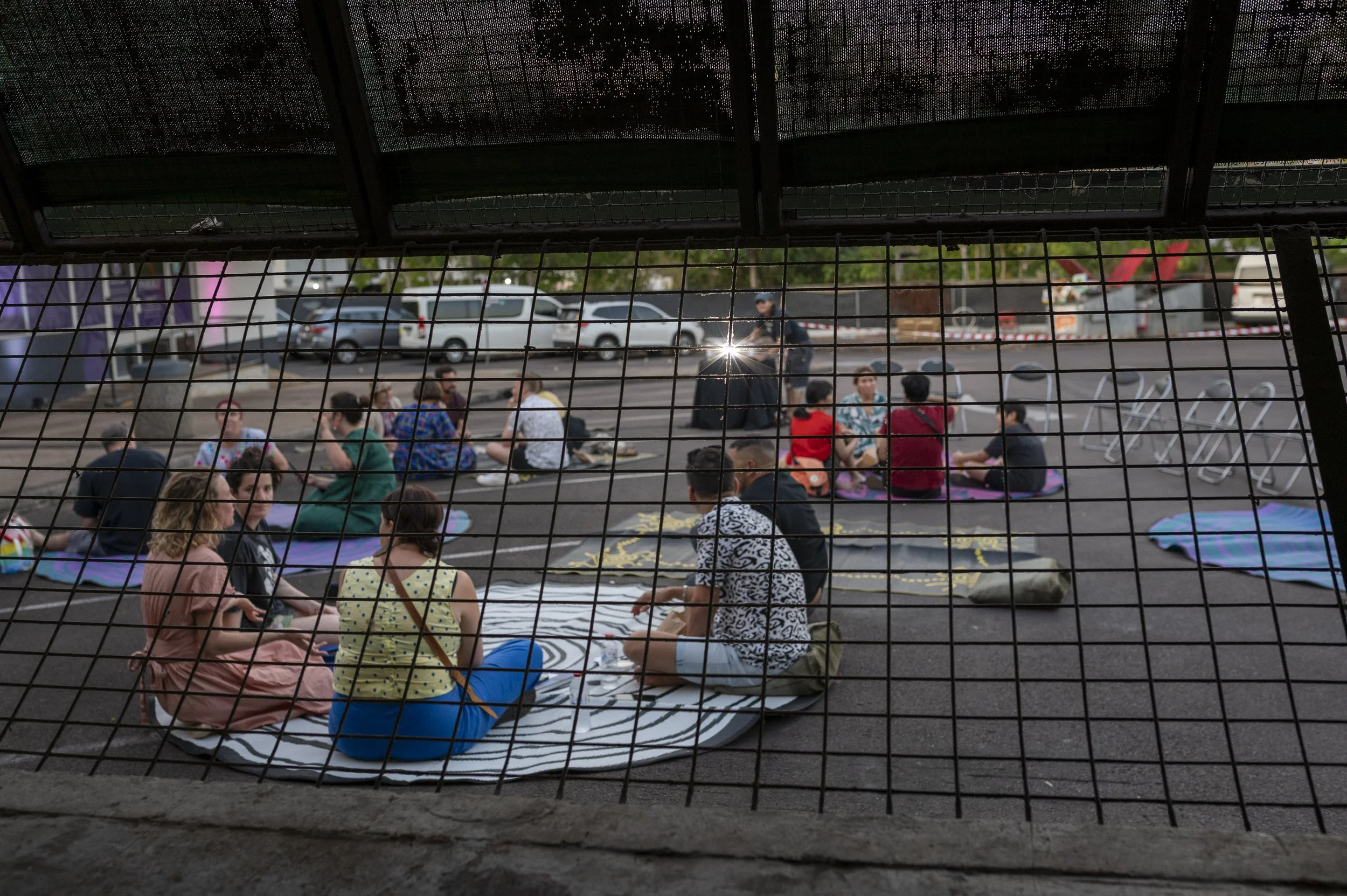








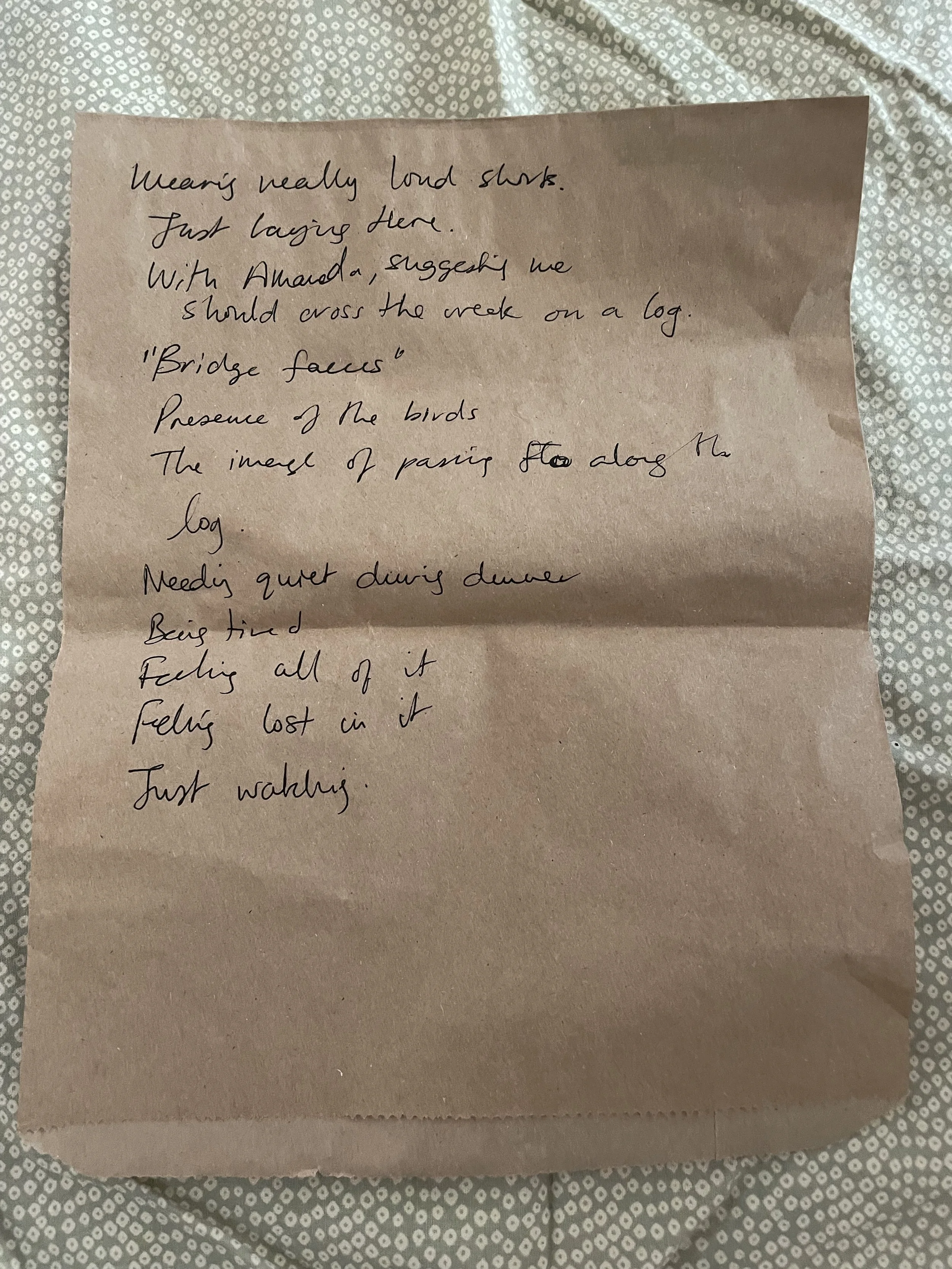
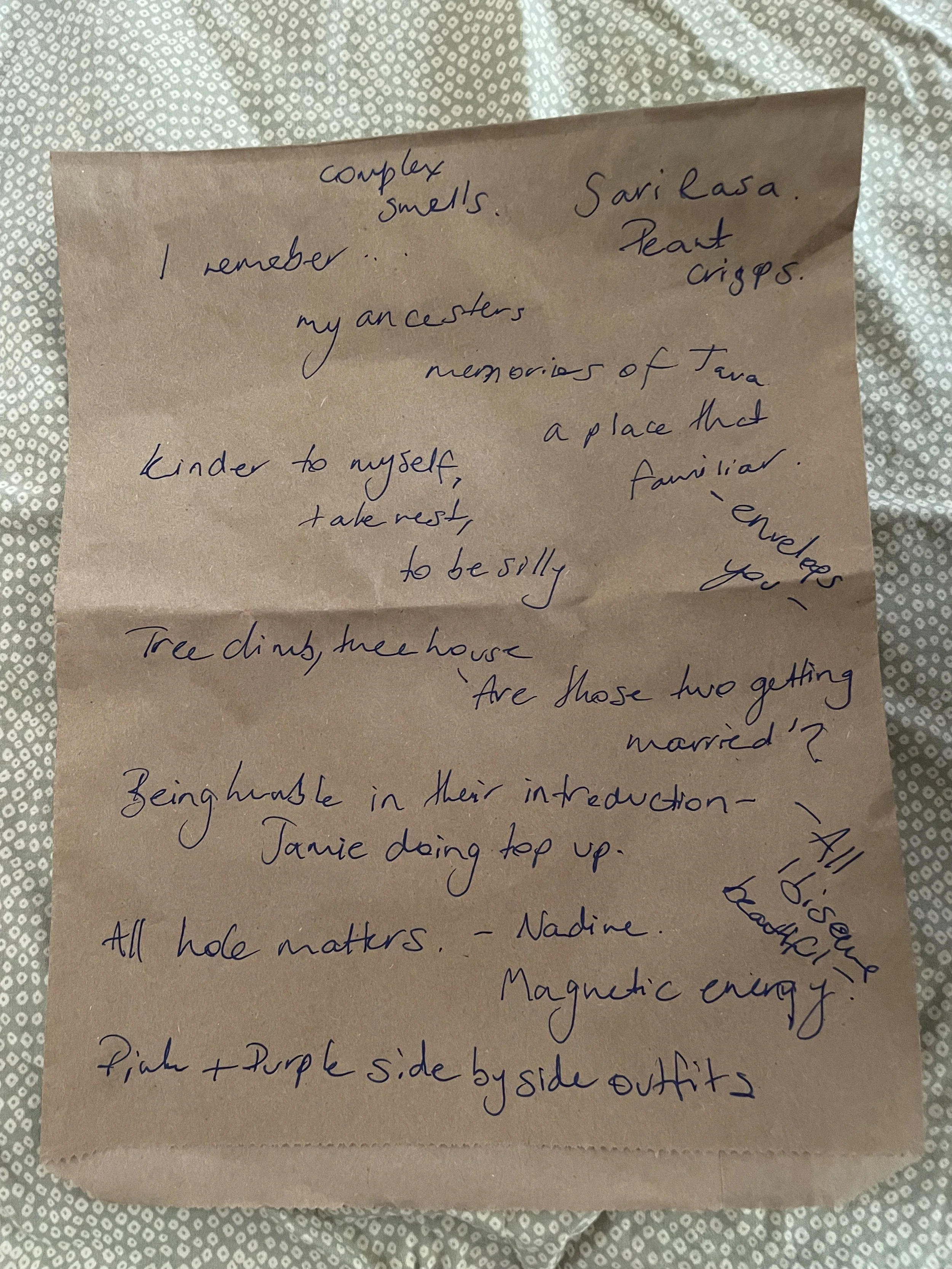


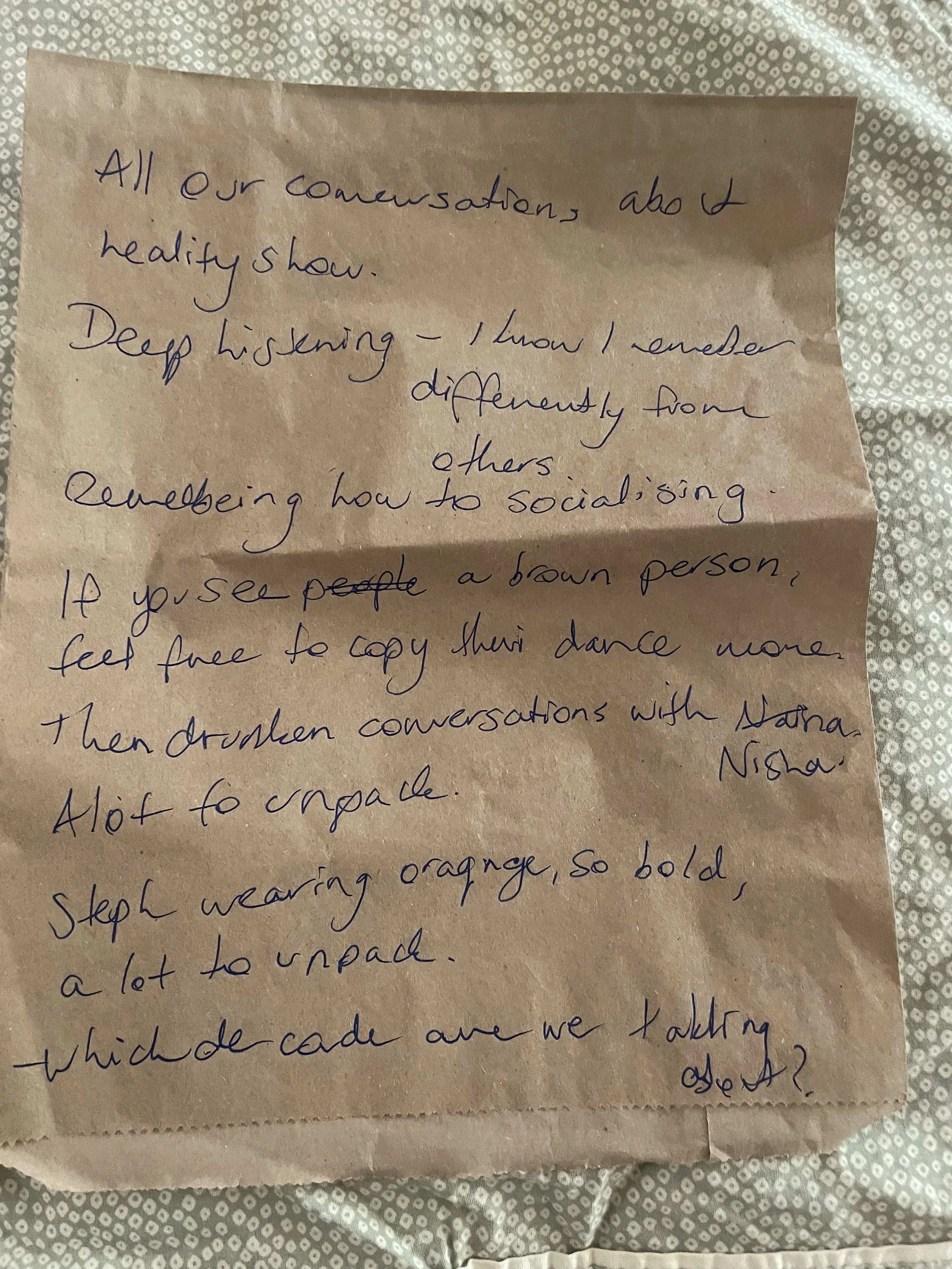
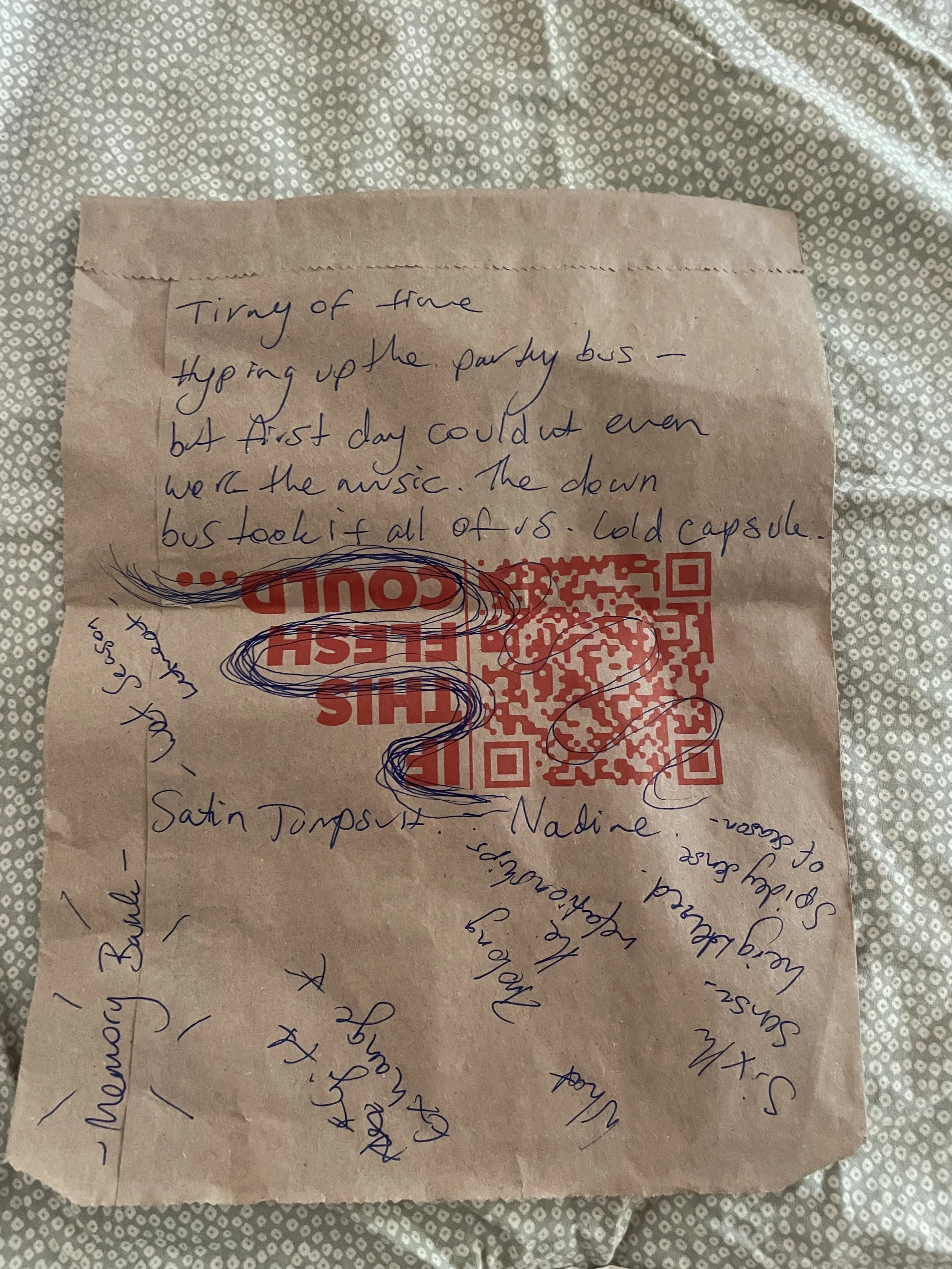

“Through a long and steady friendship built over many years with Britt Guy who works under the moniker, ACCOMPLICE, Next Wave invited five artists from around the continent to spend time here in Larrakia country, meeting, listening and witnessing the particular and deadly way that artists local to this area work. Hosted as part of Darwin festival, 13 of us took office in an empty shop at the Rapid Creek Markets. Amidst the hustle of the markets there we were, a group of artists treating our time, connection, dialogue, our right to complaint, our innate hope and visions of the future with the same amount of urgency as getting you your flat chilli noodles served to you in that small but perfect Sunday morning window. We named this exchange MarketMarket in honor of the site we made our temporary studios.
We began by watching and listening to the birds of Larrakia, under the prolific and expert guidance of Dr Amanda Lilleyman aka Dr Bird, we dined at long tables amongst exhibitions at Coconut Studios the Northern Centre of Contemporary Art in a somewhat clandestine style. We experienced the incredible gush of joy that was the Sangeet at Darwin Festival and we presented experimental works by Matty van Roden and Carlo Ansaldo, Mikaela Lee, Kelly Beneforti and James Mangohig.
All amid the market at night, while spotlighting three local vendors and their heritage cuisine. We even swam at Nightcliff beach under watchful local eyes.
I’m not gonna lie, it was awesome and there was not an outcome, deadline or KPI to be seen. I left with this exchange with Dr Bird ringing in my mind almost like a curse she bestowed on me - I asked her, once you start listening to the birds, can you switch it on and off or are you always hearing them? She said, no, I can’t turn it off or choose when to listen and now that you’ve started listening, you’ll never be able to turn it off, you’re fucked mate.
As a guest, this is the way I love to meet a country. Through its artists and their conversations. It makes me wonder: Why would I bring in another conversation, sounds from somewhere else when there is already so much birdsong to listen to here? Perhaps, in time I would, but for now, I’m blessed and cursed with the need to listen to what’s here first.
I want to be straight up here and confess to you that this was not Next Wave who designed this exceptionally led experience of the riches of Larrakia Country through the eyes and ears of artists that choose to live and work here. This careful programme was curated by Accomplice and co-produced by Next Wave. My experience of care from Accomplice was passionate, thoughtful, detailed and left deep and long lasting impressions on all who participated. It left me with a deep sense of what it means to make a choice to stay and invest in the rhythms, the seasons, the particular sway of life in Larrakia, rather than run to the supposed powers of big city arts markets.
I also want to say that the process was not always a box of birds - it consisted of hard conversations, the drawing and redrawing of boundaries, the constant defining and redefining of shared values, negotiations of trust. I had to reckon with the independent status of Accomplice, bringing their hard won local knowledge and relationships to a Next Wave Program without the financial security that my organization is privileged to have and operate under. I’m proud that this process was difficult. The project was too good for us not to pay close and careful attention to it. It demanded our time, our risk and our investment. This project for us is exactly what our shift away from tired festival and box office models is about. And I thank Accomplice, from the bottom of my heart for challenging me to step up to the plate with them and making me better at my job.
For Next Wave, we commit to and celebrate the chance to turn the spotlight away from us and the East coast, and shine it on this territory and its people who we consider, are already light years ahead of us in using the practice of using care to curate artful experiences for their local community.
The lady at the samosa shop tells me - they’ve never seen the Darwin festival here, it’s so good that this time, they’ve come to us. Usually we are too busy cooking early in the mornings and closing late at night to enjoy the festival. When Britt Guy walks through the Rapid Creek markets the stallholders know her by name and the landlord trusts her with his only set of keys. This is the kind of relationally led care that Next Wave looks up to and is privileged to work with.
It strikes me that if you want to find tangible examples of how to curate with care, you don’t need to look very far at all. Perhaps start by listening to your own birdsong. I don’t have anything new to tell you that isn’t already happening in your communities, and today alone if proof of that. Care is local, and it begins with how you treat, see and hear one another. It begins with where you are in Time and Place.
A mantra often cited during our time here was Pauline Oliveros’ phrase “walk so silently that the bottom of your feet become ears.” It’s such a hard thing to do. To fall silent, to step back. To look. To listen. Once you truly begin to listen to each other, and to your independent artists, you’ll never stop. You’ll be fucked mate!”
Nisha Madham - Lead Creative Producer - Next Wave
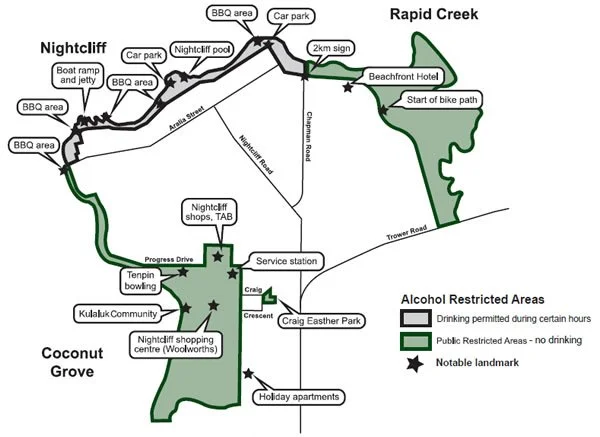




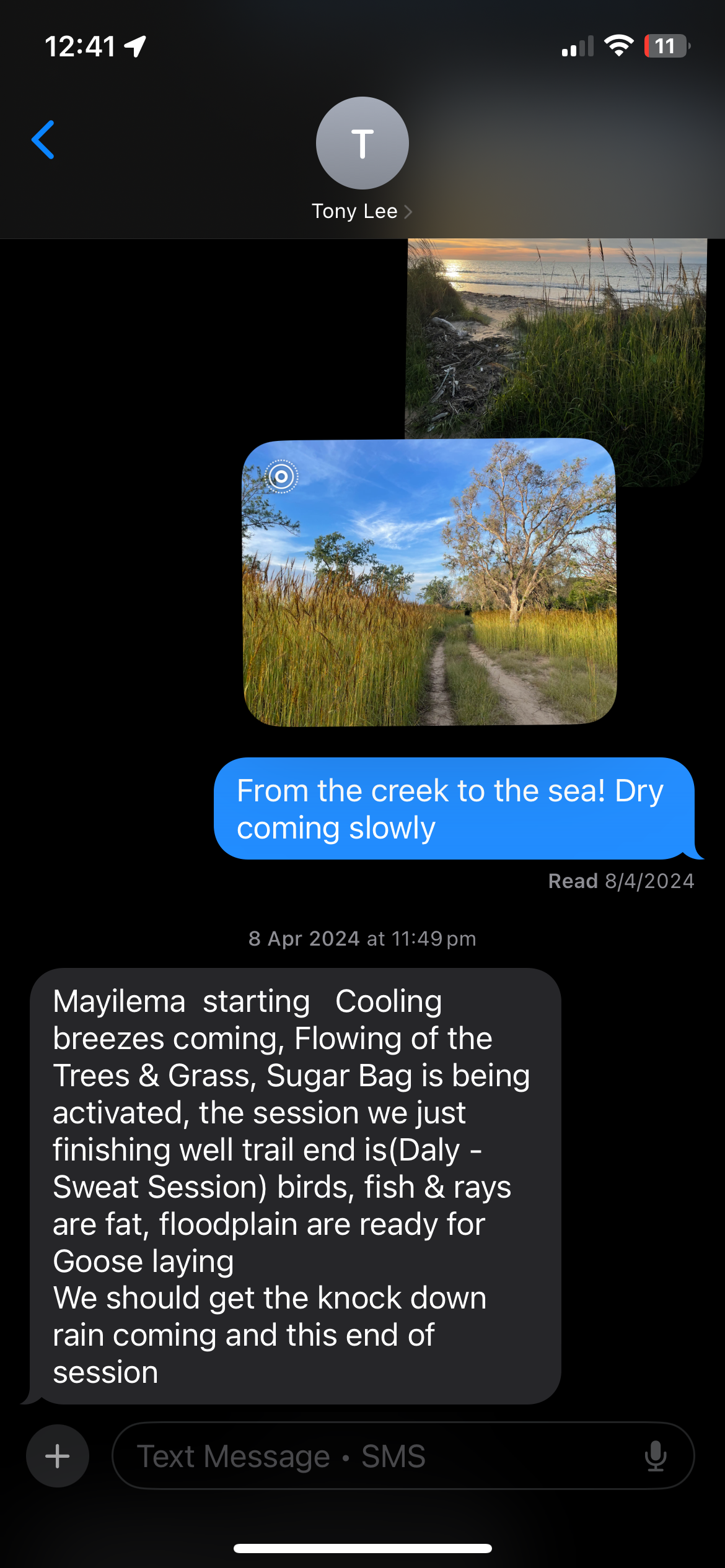

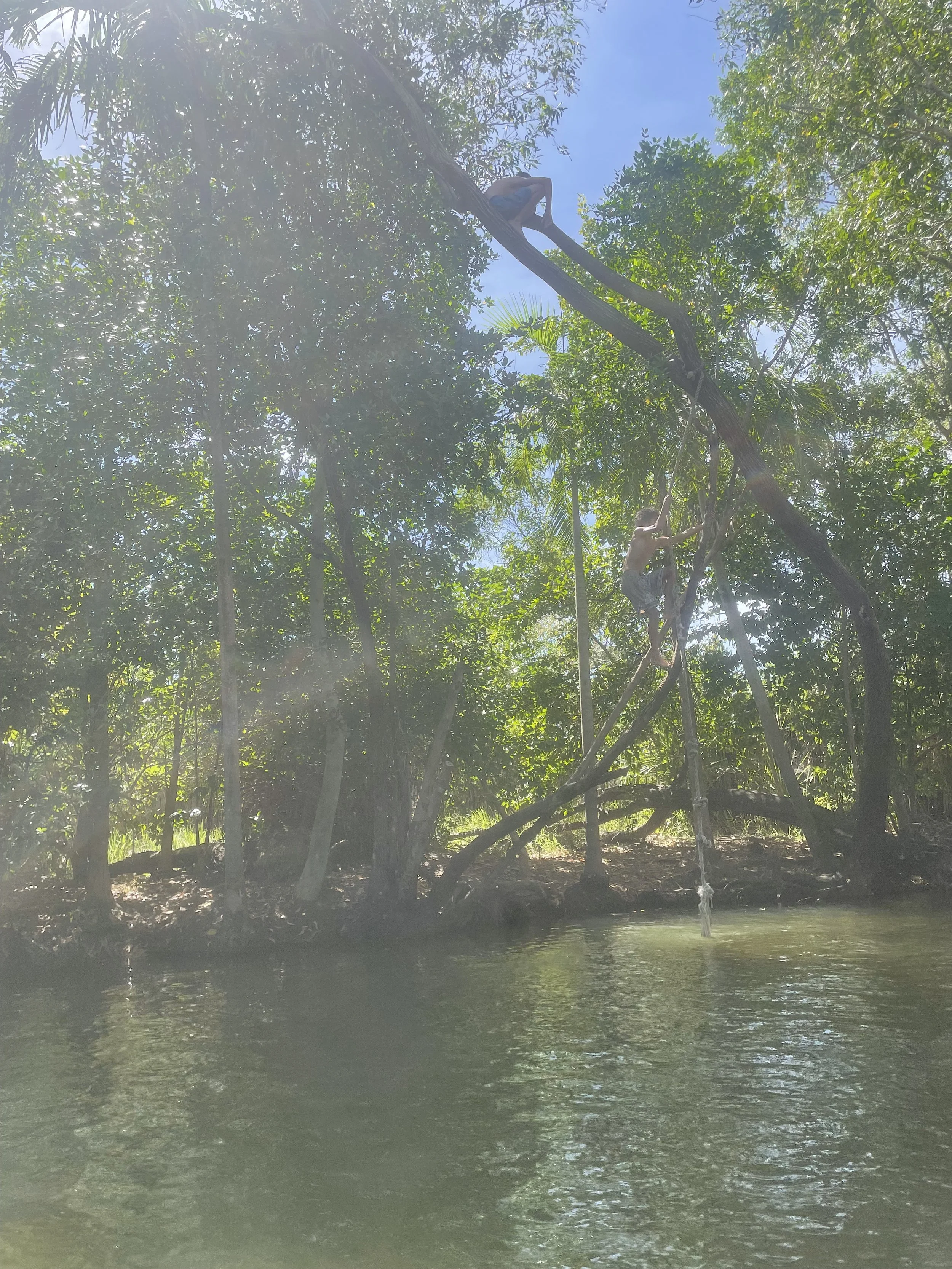


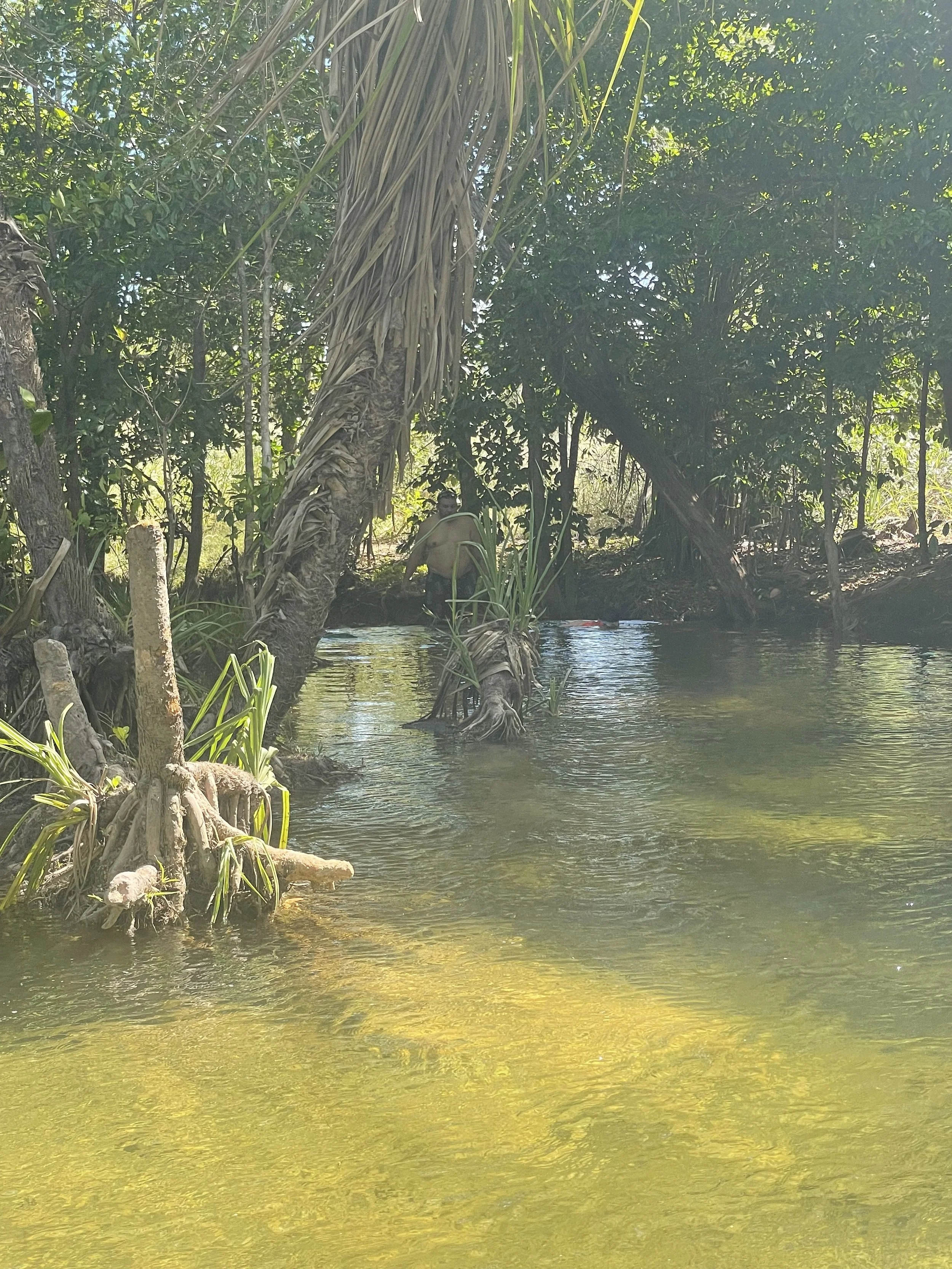

Listen to Gurambai
A soundscape across seasons.
An invitation to slow down, to notice, to be with place.
Exhibition Notes
Guy, B. (2023-2025) White Rock Swimming Hole at Rapid Creek across the seasons (photographs). Personal collection.
a. Darwin Festival, 2025. MarketMarket page on Darwin Festival website [screenshot]. Darwin Festival. Available at https://www.darwinfestival.org.au/past-event/marketmarket/ (Accessed: 15 April 2025).
b. Darwin Festival, 2025. Radical Hospitality: MarketMarket Feed page on Darwin Festival website [screenshot]. Darwin Festival. Available at https://www.darwinfestival.org.au/past-event/radical-hospitality-marketmarket-feed/ (Accessed: 15 April 2025).
van Roden, M. (2023) MarketMarket [video]. In: MarketMarket Collaboration. Available at: https://www.creativeaccomplice.com.au/program/marketmarket (Accessed: 15 April 2025).
Accomplice, 2025. MarketMarket page on Accomplice website [screenshot]. Accomplice. Available at https://www.creativeaccomplice.com.au/program/marketmarket (Accessed: 15 April 2025).
Accomplice, 2023. MarketMarket Exchange Schedule [internal document]. Unpublished.
Guy, B. (2023) MarketMarket Exchange (photographs). Personal collection.
Tassone, P. (2023) Radical Hospitality: MarketMarket Feed [photograph]. Supplied for MarketMarket at Darwin Festival. Unpublished.
Guy, B. (2023) Images of reflection notes (photographs). Personal collection.
Guy, B. (2023) Email to Michaela Nutt [screenshot]. Personal communication, 14 November 2023.
a. Guy, B. (2023) MarketMarket Exchange (photographs). Personal collection.
b. Madham, N. (2023) Curation as care [unpublished speech]. Delivered at: Meeting of Arts Professionals Conference, Darwin, 20 November 2023.
a. Rapid Creek Landcare Group n.d., Map: Trower Rd to McMillans Rd, Rapid Creek [map], Rapid Creek Landcare Group, Darwin.
b. Google Maps 2025, Rapid Creek suburb aerial image [map], Google. Available at: https://maps.google.com [Accessed 5 May 2025].
c. Northern Territory Government n.d., Alcohol restricted areas: Coconut Grove, Rapid Creek, Nightcliff [map], Northern Territory Government. Available at: https://www.nt.gov.au [Accessed 5 May 2025].
Lee, T. and Guy, B. (2024) Text message exchange about Gurambai [screenshot]. Personal communication, September 2024.
Guy, B. 2025, Photographs of people with Gurambai (Rapid Creek) [unpublished images], Larrakia Country.
a. Guy, B. (2025) Gurambai Flow, Rapid Creek [audio recording]. Unpublished.
b. Guy, B. (2024) Surround Sound, Rapid Creek [audio recording]. Unpublished.



